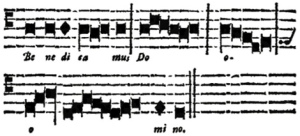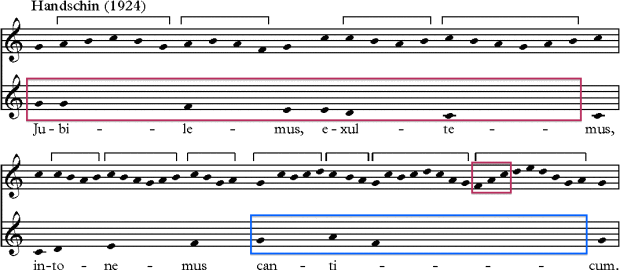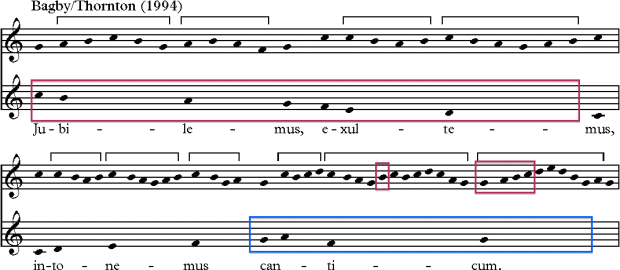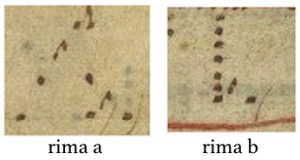The "Benedicamus Domino" is a formula of farewell used at mass and in the office of the hours. The Benedicamus occupies a crucial position in the development of Western polyphony, given the very important role that during centuries XI to XIII as the basis for the composition of organa and conductus and motets.
In this first article dedicated to the Benedicamus, will study a florid organum this text-based and included in one of the most ancient sources of the so-called School of Saint martial of Limoges: "Jubilemus, exultemos",
The "Benedicamus Domino" and their tropes

The Benedicamus is a simple formula of farewell consisting of intonation for the officiating "Benedicamus Domino" (bless the Lord) and the reply of the Assembly (or choir) with the "Deo Gratias" (Thanks be to God).
This formula of farewell is mainly used in the trade, but it is also used in the mass, as an alternative to the "Ite missa est" (go in farewell), formula that ended up giving name to the "mass".
Melodies of the Benedicamus medieval repertoire is very varied, and covers from simple formulas in Recitative, even lush melodies melismaticas, occasionally "borrowed" from other chants of the office or of the mass.
| Una version simple del �gBenedicamus Domino ? Deo gratias�h. | |
| Una version elaborada del �gBenedicamus Domino ? Deo Gratias�h. |
-
It is composed on a text tropado: A Latin poem of eight verses ending with "Benedicamus Domino", amplifying and contextualizing its meaning with regard to the celebration of Christmas.
-
It is made in style of florid organum, in which an organal voice very melismatic overlaps to a main voice of syllabic style.
- The main voice is not based on a plainsong prior, but it seems new (or recent) building which is precisely what distinguishes the conductus of the organum.
intonemus canticum.
2. Redemptori, plasmatori,
salvatori omnium.
3. Hoc nathali, salutari,
omnis nostra turmula.
4, Deum laudet, sibi plaudat,
per eterna secula.
5. Qui hodie de Marie
utero progrediens.
6. Homo verus, rex atque herus
in terris apparuit.
7. Tam beatum, ergo natum,
cum ingenti gaudio.
8. Conlaudantes, exultantes,
Benedicamus Domino.
Los problemas de la notacion
-
The determination of heights is sometimes questionable. Especially the descending start of the lower voice, which seems to divide the field of descending fifth (Sol-Do) in six heights instead of five.
-
The synchronicity of voices is equally vague.
| Interpretacion del Ensemble Gilles Binchois, basada en la edicion de Handschin [1924]. | |
| Interpretacion del grupo Sequentia, basada en una edicion propia [1994]. |
Analisis musical
Jubilemos, exultemus is an organum in mode of Mixolydian structured in eight sentences (verses), each of which syllables can be divided into two semi-phrases of 8 + 7.
1. La voz principal

Partitura del organum �gJubilemus, exultemus�h recogida en el MS fl 1139 de la Biblioteca Nacional de Paris.
2. La voz organal
3. Harmony and global structure
3.1 Versos 1 y 2
| Jubilemus, exultemus (C) / intonemus canticum (GA) |
| https://dl.dropboxusercontent.com/u/20631049/HM/U03/jubilemus_s01.mp3 |
| Redemptori, plasmatori (C), salvatori omnium (GA) |
| https://dl.dropboxusercontent.com/u/20631049/HM/U03/jubilemus_s02.mp3 |
3.2 Versos 3 y 4
| Hoc nathali, salutari (G), omnis nostra turmula (GB) |
| https://dl.dropboxusercontent.com/u/20631049/HM/U03/jubilemus_s03.mp3 |
| Deum laudet, sibi plaudat (G), per eterna secula (GB) |
| https://dl.dropboxusercontent.com/u/20631049/HM/U03/jubilemus_s04.mp3 |
3.3 Versos 5 y 6
| Qui hodie de Marie (G) utero progrediens (C) |
| https://dl.dropboxusercontent.com/u/20631049/HM/U03/jubilemus_s05.mp3 |
| Homo verus, rex atque herus (GA) in terris apparuit (G) |
| https://dl.dropboxusercontent.com/u/20631049/HM/U03/jubilemus_s06.mp3 |
3.4 Versos 7 y 8
| Tam beatum, ergo natum (B), cum ingenti gaudio (G) |
| https://dl.dropboxusercontent.com/u/20631049/HM/U03/jubilemus_s07.mp3 |










